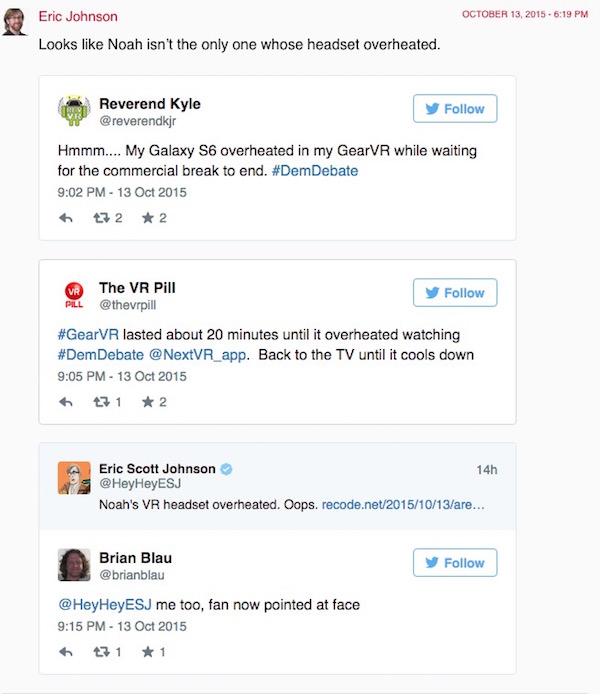
Last night’s Democratic debate set viewership records: more than 15 million people tuned in on CNN, and at one point there were 980,000 concurrent live streams on the network’s website. But beyond the cable and online viewership, there was another audience CNN was courting: the lucky few who own a Samsung Gear VR headset.
Using four virtual reality cameras throughout the debate hall, viewers watching on the virtual reality stream could feel like they were in the room with Jim Webb as he smirked about the time he killed an enemy soldier in Vietnam.
The Washington Post also used the debate to experiment with VR, producing a 360-degree tour of the post-debate spin room.
While the VR audience was certainly small — the Samsung headset is only available now in an “Innovator Edition,” with a cheaper $99 model coming out next month — CNN viewed it as an opportunity to experiment with a new technology that could be a substantial part of news in the future. Presidential campaigns and elections have long been opportunities for news organizations to try out new coverage methods (remember will.i.am’s appearance on CNN in 2008 via hologram?) because even though it’s a major event, it’s one with months of lead time for preparation and testing.
Currently there are people in 73 countries watching #DemDebate in virtual reality – including someone in Uzbekistan pic.twitter.com/fVtCul9GDc
— Jason Farkas (@JasonFarkas) October 14, 2015
CNN also recorded (but didn’t livestream) the most recent Republican debate last month in California; the company said that the VR streams afford its audience “the opportunity to experience these historic political events through their own lens.”
So what was it like actually watching the debate on VR?
Mashable’s Jason Abbruzzese wrote that he gave up on watching the debate on the VR stream after about 45 minutes due to the weight of the headset and the heat it generated. Also, he wrote, that he missed the fun of Debate Twitter:
I’m also kind of lonely. I can faintly hear my coworkers cracking jokes in the background, and I already miss my Twitter feed. There’s no interactivity on this thing, although it would be cool if they eventually added it.
Recode liveblogged its experience watching the debate in VR. They ultimately cut out a half-hour early after none of the reporters wanted to put the headset back on because…it kept overheating. This, apparently, was a common experience.

In his review, CNET’s Max Taves said that VR rendered the debate unwatchable:
When CNN’s average TV viewers saw Clinton’s pearl earrings, all I saw was a blonde-haired blob on stage in a blue pantsuit. And when everyone else was watching Sanders sporting those 1970s-chic glasses, what I saw was an old white guy in a suit who appeared mildly fond of moving his hands.
And the audience? Forget about them. Individual reactions to the debate were completely impossible to read.
So while the candidates and the audience were mostly indistinguishable on stage, several huge CNN logos were always in sight. I counted nine in one shot. Fans of the network’s Anderson Cooper had something to be happy about. Besides his cameramen, who appeared below me a few times, Cooper was as close as you got to seeing a human up close in virtual reality and that was still from about 15 feet away.
On Twitter, The Verge’s Adi Robertson said that regardless of the technology, the debate was just a boring event to watch in VR:
you know what really benefits from full immersion
five people standing perfectly still for two hours
— Adi Robertson (@thedextriarchy) October 14, 2015
currently looking at anderson cooper’s reflection on the debate floor
this is the most interesting thing in the vr debate
— Adi Robertson (@thedextriarchy) October 14, 2015
Stephen Colbert seemed to agree. Earlier this month, he watched a replay of the Republican debate in VR, but, using the magic of television and virtual reality, he decided to ultimately leave the debate, go to a bar, and fly off on his dragon after getting into a fight with a police officer.